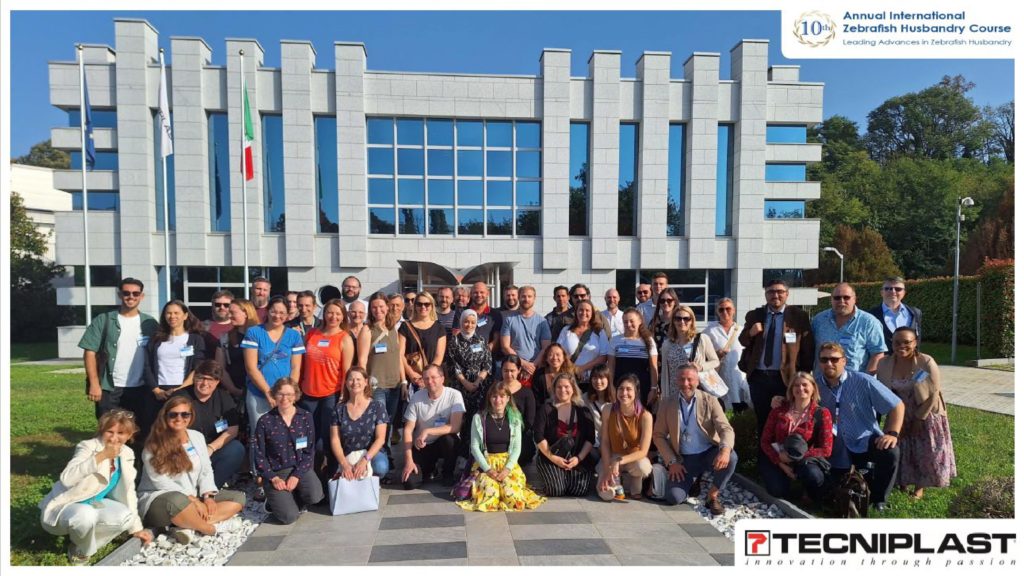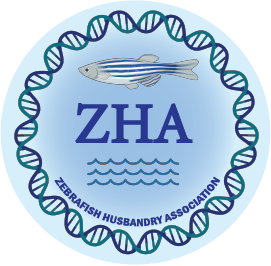Exploring the Wonders of Zebrafish: My Insights from the 10th Annual International Zebrafish Husbandry Course – by Candace Sparkman
I was immensely fortunate to receive a $1000 grant from the Zebrafish Husbandry Association,
which opened the doors for me to attend the 10th Annual International Zebrafish Husbandry Course in the enchanting city of Buguggiate VA, Italy, hosted by Tecniplast. From October 9th to 13th, 2023, I had the privilege of immersing myself in a world of zebrafish research and husbandry, and the knowledge I
gained during this experience has been nothing short of transformative. I’m profoundly grateful for the
opportunity to attend this conference, and I’m excited to share some of the invaluable insights I gathered
about these fascinating creatures.
Understanding Zebrafish Natural History and Behavior
The course kicked off with a captivating presentation by Bruce Newell, a professional who started his
career in retail aquatic stores and is now the Senior Technical Officer, Aquatic Aviary and Wildlife at
Deakin University with 26 racks of Zebrafish, each endearingly named George. Bruce’s talk went into the
natural history and behavior of zebrafish, shedding light on some remarkable aspects:
● Zebrafish have an R-type breeding strategy, characterized by high reproductive rates and minimal
parental investment.
● The name “Danio” finds its roots in “Rice Field,” alluding to the fish’s native habitat.
● Bruce highlighted the existence of nine recognized zebrafish species, with two more under
review, all of which belong to the carp family.
● Zebrafish have laterally compressed bodies and upward-facing mouths, adapted to their natural
environment in India, where fluctuating temperatures and water quality due to monsoons are the
norm.
● Observing zebrafish in their natural habitat is challenging due to limited research, making it
difficult to gain insights into their age range, which raises ethical concerns.
Delving into Water Quality Fundamentals
Another eye-opening session was conducted by Karin Finger-Baier, where she talked about the intricate
world of water quality fundamentals, a vital aspect of zebrafish husbandry:
● Karin emphasized that tap water quality can be influenced by plumbing and source, while reverse
osmosis (RO) water lacks buffering capacity, making pH regulation a priority.
● Maintaining stable pH levels around 7.5 is paramount, as deviations can lead to low oxygen
levels and high ammonia (NH3) concentrations, jeopardizing zebrafish health.
● Temperature control, maintaining it between 24-28°C, was underscored as essential for zebrafish
well-being, given its influence on growth rates and food consumption.
● Karin’s comprehensive insights extended to nitrogen management, covering ammonia (NH3),
nitrite (NO2), and nitrate (NO3) levels. Proper control is vital to maintain a healthy aquatic
environment.
Diving Deeper into Anesthesia, Euthanasia, and Stress in Zebrafish
One of the most eye-opening sessions was also conducted by Karin Finger-Baier, further emphasizing the
significance of fish welfare and care. Karin’s session focused on zebrafish anesthesia, euthanasia, and
stress management. It was enlightening to learn about the various methods and their implications:
● Anesthesia, a critical aspect of zebrafish research, means “no feeling,” and its humane
administration was a central theme. Karin highlighted the use of MS-222, commonly known as
Tricane, as a local anesthetic, while underscoring the importance of protecting it from light to
maintain its effectiveness. She also discussed alternative options, such as clove oil, which is quick
and cost-effective, and lidocaine, known for its quick action and analgesic properties.
Additionally, the use of propofol was discussed, despite its short duration and solubility
challenges.
● The diverse techniques ensure humane end-of-life care. However, Karin also raised a crucial
point about German law, which prevents the sacking of fish without a health concern, resulting in
a population of aging fish in zebrafish facilities.
Advancements in Zebrafish Procedures, Genetic Colony Management, and Personnel Training
Carrie Barton’s session provided a deep dive into zebrafish procedures, genetic colony management, and
personnel training. She spoke on zebrafish procedures and techniques and unveiled innovative methods
that can greatly benefit zebrafish researchers.
● Shipping of fish in ridgid cube containers and the use of ammonia (NH3) binders.
● Advancements in genotyping fish using skin swabs and techniques like cryopreservation and in
vitro fertilization opened new avenues for zebrafish research.
● The session emphasized the importance of staying up to date with the latest techniques to ensure
the highest standards of research and husbandry.
● The section on genetic colony management emphasized the potential risks associated with
inbreeding, genetic drift, and founder effects. These can lead to various health problems and
reduced reproductive success in zebrafish populations.
● Strategies to mitigate these issues included monitoring clutches, reducing sibling mating, and
adhering to a 3-to-1 rule, involving outcrossing to the AB strain every three generations.
● By maintaining genetic diversity and utilizing innovative methods, researchers can ensure the
health and vitality of zebrafish populations for years to come.
In conclusion, my journey to the 10th Annual International Zebrafish Husbandry Course was a
remarkable experience that enriched my understanding of these remarkable creatures. From their natural
history and behavior to the intricacies of water quality management, anesthesia, and euthanasia, I gained a profound appreciation for the research-based approach to zebrafish husbandry. Exploring advanced
techniques, genetic colony management, and personnel training emphasized the need for continuous
learning and adaptation in the field of zebrafish research.
As I return from this enlightening event, I carry with me a vision for the future of zebrafish
research – one that is rooted in compassion, innovation, and the unwavering commitment to
understanding these fascinating aquatic creatures. I’m profoundly grateful for the opportunity to have
attended the conference and the support of the Zebrafish Husbandry Association. With these newfound
insights, I am excited to contribute to the vibrant community of zebrafish researchers, working towards a
brighter future for both the scientific world and these remarkable fish.

